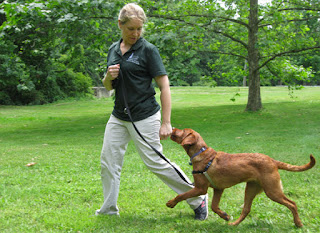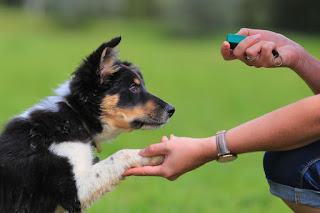Common dog training mistakes
Are you training your dog in the best way possible? The fact that you are training your dog in the first place means you're doing something right. Don't let minor mishaps get in the way. Though they may seem insignificant, you may be surprised to learn that certain factors can slow down your dog's progress. Here are the most common mistakes people make during dog training. Are you guilty of any of these dog training mistakes?
Waiting Too Long to Start Training
Young puppies might not be ready to learn advanced actions, but you should begin to work on house training and basic commands. Over time, you will you forge a deeper bond with your dog. He will mature and grow accustomed to the routine of training sessions. Then, you can try fun things like dog tricks and advanced training (like agility or therapy).
bikejoring equipment
Not Training Enough
Training is not something you can do once and be done with it. You will get the best results if you train your dog regularly. Pick one thing to work on at a time and hold 10- to 15-minute productive training sessions at least two to three times per week. Find fun new things to teach your dog, but occasionally revisit an old action that your dog already does well.
Your dog is never truly finished training. Ideally, you will always be training your dog, even as he ages. Ongoing training can help keep your dog's skills sharp. Also, training sessions are fun for your dog and a great way for the two of you to bond.
Taking a "One-Size-Fits-All" Approach
Don't read just one book on dog training and decide that's all you need to know. The same goes for talking to that one friend you have who knows about dogs. There are many successful training styles and programs out there, but no two dogs are exactly alike. Sometimes you need to take advice from several sources and use all the information to develop your own training program.
Try out a few different things with your dog and see what works. Combine different training styles to customize a plan that fits you and your dog. You might even want to try a few different training classes. Don't give up too fast, but also don't be afraid to change things up if something isn't working.
attack dog training suit
Inconsistency
Consistent responses are essential to dog training on every level. When you are inconsistent in training, you can confuse your dog. You may also find yourself accidentally reinforcing undesired behaviors.
Let's say you have a rule that your dog is not allowed on the couch. But, you find yourself making the occasional exception and letting him up there for one reason or another. If you turn around and get mad at him for being on the couch, he won't understand why it's ok one moment and not the next.
Begging is another example of this mistake. If your dog never gets food from people who are eating, he will not develop the habit of begging. He might try it a few times at first, but consistently ignoring your dog or saying "go to your place" will discourage begging. However, if someone gives him a bite of food, he will associate begging with a reward and he'll keep begging in the future.
Another example of inconsistency is rewarding your dog when he "sort of" does something. If you are training your dog to lie down, you reward him when his whole body is on the ground. In the future, if you give him a reward for "lie down" BEFORE his whole body is on the ground, you are being inconsistent. The next time you say "lie down," he may become confused and give you the "sort of" version again.
Impatience
Dog training takes time, and each dog learns at a different pace. Getting stressed out and acting frustrated because your dog isn't catching on to something is not going to help. In fact, it will only make things worse because your dog will also become stressed.
If your dog is struggling to learn something, consider whether or not this is a good time to train. Has the session gone on for too long? Remember to keep dog training sessions short (about 10 to 15 minutes) and end on a positive note. Or, you may try breaking down the behavior into smaller parts and train each one separately. The action/cue "roll over" is often trained in steps for this very reason.
The next time you find yourself feeling impatient, look at the time. If it has been long enough (or if your dog seems frustrated or disinterested), simply wrap things up. Otherwise, you can try breaking up the training into smaller parts. Either way, be sure to end the session with a success, even if it means going back to "sit."
Another example of impatience is this: You ask your dog to sit and he doesn't. So, you keep saying the word "sit" and he finally sits after 3 to 5 times of saying sit. Then, you reward him with a treat. Basically, you are teaching him that the command was merely a suggestion. You should consistently say the command once and wait for the result. If your dog does not comply the first, you should wait several seconds and start from the beginning (getting his attention first).
sport dog contain and train
Harsh Discipline
Most modern dog trainers agree that using punishment in dog training is not very effective. In general, dogs are more likely to perform for rewards via positive dog training. The use of mild aversives (like the spray bottle or a penny can) can be helpful in some situations and do not tend to cause harm. However, other things can create a dangerous situation. Harsh discipline involves actions such as yelling, hitting, alpha rolls, staring down, grabbing the scruff of the neck, and leash jerking.
These actions can have a few consequences:
o They can provoke an aggressive reaction from your dog, putting you or other people in danger.
o They can cause your dog to become fearful.
o They may even cause physical harm to your dog.
If you think harsh discipline is necessary so you can "assert dominance" over your dog, then you are going about this all wrong. The notion of humans as a "pack leader" is outdated and stems from inaccurate research about dogs and wolves. Please do some research and learn how to truly earn your dog's respect. The training process should be a fun way to bond with your dog, not a bullying session.
Getting the Timing Wrong
Your dog won't know he has done something right unless you tell him in a way he can understand. Here's where positive reinforcement and timing comes in. Many trainers suggest using a clicker or a short word (like "yes") to mark desired behaviors. Then, immediately follow up with a reward to be sure it's associated with the clicker or word. Make sure this all happens very quickly (within a second or two). If the reward comes a few seconds too late, your dog will associate the award with another action. Positive reinforcement is especially important during early training when you are trying to get your dog to connect actions to cue words.
The same thing goes when it comes to correcting your dog's undesired behaviors. If you choose to use aversives (which should be mild and kept to a minimum or avoided altogether), make sure you introduce the aversive immediately as the action is taking place. If your dog is peeing in the house and you don't catch him until he is done, then there is nothing you can do. Any punishment after the fact will be associated with something else (NOT the action of peeing in the house). Your dog may learn to be afraid when there is pee on the floor, but he won't actually learn not to perform the action unless you catch him in the act.
Calling Your Dog to You for Something Unpleasant
Would you want to go to a person if you knew you were going to get in trouble, be yelled at, or have some other bad things happen? Of course not, and neither would your dog. Every time you call your dog to you in order to do something unpleasant, you are essentially punishing him for returning to you. Eventually, it will discourage your dog from coming when called. Having a strong recall is one of the most important things you can teach your dog. Don't ruin it with this mistake.
If you have to do something your dog won't like (such as a bath or a nail trim), simply go and get him instead of calling him. If you are angry about something, try to calm yourself down before issuing any kind of command/cue to your dog. Remember that your dog will learn nothing from being punished or yelled at after the undesirable behavior occurs.
service dog counterbalance harness
Reinforcing the Wrong Behavior
One of the most common mistakes made in dog training is to accidentally reinforce undesired behaviors. You may not even think of it as rewarding or reinforcement. Examples include comforting your dog when he's frightened, letting him in right away when he barks, or even giving him a stern talking-to when he misbehaves.
Our dogs are social creatures who seek our attention. Giving attention of any kind can tell your dog that his current behavior is good and should continue. To your dog, even negative attention is better than none at all. If your dog is doing something undesirable, the best thing you can do is to deny attention until the behavior stops.
Note: If the undesired behavior is self-rewarding, such as chewing furniture or getting into the trash, ignoring your dog is not the best idea. Instead, redirect your dog's attention to a healthy activity that rewards, such as playing with a toy or going through training exercises.
Not Proofing Behaviors
So many people forget about this essential part of the dog training process. Proofing a behavior means to practice it in different settings with various distractions. Once your dog has learned to sit in your living room, all he knows is that sit means "put my bottom on the ground in the living room." When you are in the yard or at the park and other dogs are around, the word sit means little or nothing to him. When you start training an action, being in a quiet, controlled setting. Then, move to different locations with each session, gradually increasing the number of distractions. This will really help fine-tune your dog's reactions to your cues.


Comments
Post a Comment